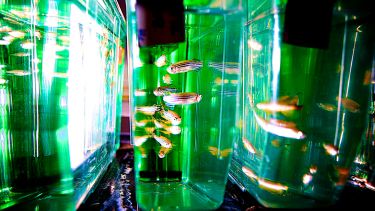Why study Zebrafish?
Zebrafish (Danio rerio) have been maintained at the University of Sheffield since 1997. Today, the Biological Services Aquarium (BSA) has the capacity to hold over 112,000 fish, in over 4000 tanks and is one of the largest facilities in the UK.

This popular fish, frequently sold commercially under the name Zebra Danio, has become an important vertebrate model organism in scientific research.
The zebrafish owes much of this success to its hardiness, cold resistance, easiness to breed and variable omnivorous diet.
Key benefits
Key benefits for the laboratory include the fact that they are photoperiodic breeders, have regenerative abilities and their transparent embryos can be harvested easily and manipulated from birth.
Transparency is perhaps the most crucial of all these qualities, as this allows microscopic visualisation of cellular processes including blood-flow and wound healing.
Zebrafish are distinctly diurnal; sleeping more during the night than the day; light suppresses sleep. A standard photoperiod of 14 hours on and 10 hours off is operated and breeding is initiated from “sunrise”. More detailed information can be found here.
Breeding
Reproduction can be manipulated to any cycle required using LED lightboxes. This manipulation of the photoperiod is popular with developmental biologists, who may require developmental stages usually only reached at unsociable hours.
As oviparous breeders, successful embryo production depends heavily on the presence of eggs in females. Factors that impact upon breeding success including diet, stress, aggression, water quality, age, genetics (in-breeding) and compatibility between sexes. Breeding occurs daily and eggs are usually removed by filial cannibalism.
Once a week, embryos are collected from matings by either “marbling” or pair-mating fish. “Marbling” (the in-house name given to the breeding of shoals of fish), produces vast numbers of embryos in a variety of ways. This comes, however, at the cost of reduced parental accuracy and synchronized birth timings.
Specific pairs of fish can be bred in pair-mating tanks, which are designed to divide individual pairs overnight, reducing the risk of fighting. During “sunrise” the fish are brought together for phased breeding giving fewer embryos but defined parentage and birth stages. Both strategies are advantageous in different research methods.
After birth
After birth we have further control because being ex utero breeders, we can manipulate the speed at which the embryo can develop. In fact, the zebrafish originally attracted the attention of biologists due to its potential as a developmental model for the principles of cellular and molecular biology. Genetic engineering was employed from the offset and developed to create alterations in normal biological pathways.
Sheffield now houses over 760 genetically engineered strains, including visually detectable transgenic lines. Further validation of these fish as a model for human disease is the 70 per cent similarity between the human and zebrafish genome, which helped shift research from basic science towards medical discovery.
Medical discovery
A significant shift in funding opportunities towards medical projects has encouraged this transition further and global attention has now turned to the zebrafish’s potential as a non-mammalian model of disease – to the extent that we are now using it to study Parkinson’s disease, motor neurone disease, wound healing, cancer, cardiovascular disease and arteriosclerosis, hearing and balance, optic response, hypoxia, ageing, epilepsy and muscular dystrophy.
The BCZF has helped reveal potential drug discoveries for epilepsy, Duchenne muscular dystrophy, chronic obstructive pulmonary disease (COPD), asthma and Parkinson’s disease. These significant achievements are primarily due to the fact that zebrafish are ideally suited to high-throughput, small molecule screens.
This small, tropical fish has, over the last 40 years, become a truly very valuable tool in the pursuit of biological scientific discovery and will continue to reveal more scientific facts and discoveries.


